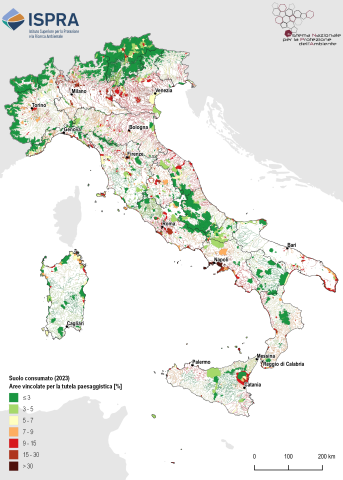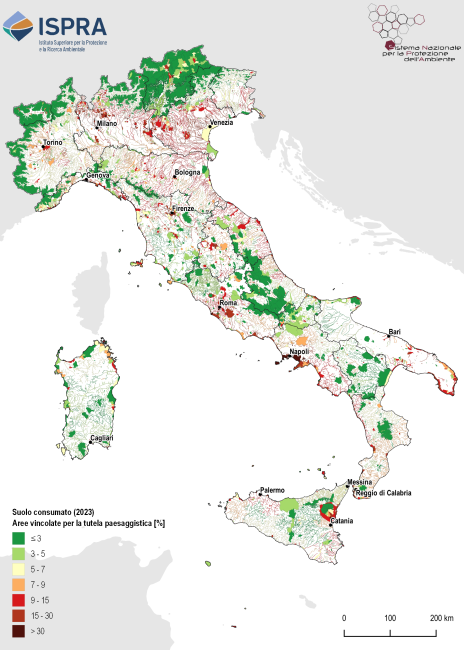Panel 1
Marco D'Antona, Marco Di Leginio, Valentina Falanga
Legislative Decree D.Lgs. 42/2004 (Codice Urbani) is the primary legal reference for the protection, conservation, and enhancement of cultural heritage (cultural assets and landscape). Protected areas, considered as a whole—those identified under Article 142 and Article 136—had a percentage of soil consumption in 2023 lower than the national average (5.43%), with an increase of just under 1,400 hectares in the last year. Campania is the region with the highest percentage of land consumed in protected areas (11%) and the largest increase, both in absolute terms (+135 hectares) and in the density of changes (3.53 m²/ha).
Soil consumption changes were analyzed within the following legally protected areas, limited to spatially defined assets (source: Environmental and Landscape Territorial Information System - SITAP), as defined in D.Lgs. 42/2004 (Codice Urbani):
- Article 142, Paragraph 1:
- (a) Coastal territories within 300 meters from the shoreline, including elevated lands (coasts).
- (b) Territories adjacent to lakes within 300 meters from the shoreline, including elevated lands (lakes).
- (c) Rivers, streams, and watercourses listed under the unified law on water and electrical installations (Regio Decreto No. 1775 of December 11, 1933), including their banks or embankments within 150 meters each (rivers).
- (d) Mountains above 1,600 meters above sea level in the Alps and 1,200 meters in the Apennines and islands (mountains).
- (l) Volcanic areas (volcanoes).
- Article 136: Properties and areas of significant public interest (ope legis).
To assess soil consumption changes in protected areas under D.Lgs. 42/2004 (Codice Urbani) between two consecutive years.
For protected areas, the reference framework is D.Lgs. 42/2004 (Codice Urbani). Concerning land and soil consumption, European environmental action programs and Agenda 21 set general objectives for sustainable land use, nature conservation, and biodiversity protection. The European Commission has long been committed to these issues.
The 2006 Thematic Strategy for Soil Protection, later withdrawn and now under discussion again, emphasized the need to implement good practices to mitigate the negative effects of soil sealing on soil functions. These goals were further specified in subsequent European strategic documents, including the Roadmap to a Resource-Efficient Europe and the Thematic Strategy on the Urban Environment (COM/2005/0718).
On July 5, 2023, the European Commission adopted a proposed directive called Soil Monitoring and Resilience. Instead of introducing an immediate Soil Health Law—as initially announced in the EU Soil Strategy for 2030—the Commission opted for a two-phase approach, prioritizing soil quality monitoring and evaluation before implementing strict legal limits, which will be assessed six years after the directive’s approval.
On August 18, 2024, the Nature Restoration Law came into force, approved under Regulation (EU) 2024/1991 [1] of the European Parliament and Council on June 24, 2024. Its main goal is to halt biodiversity loss in the EU and restore ecosystems to achieve climate neutrality by 2050, adapt to climate change, and improve food security. The regulation sets specific obligations for various ecosystems, including agricultural land, forests, and urban ecosystems, and—alongside the EU Biodiversity Strategy for 2030—establishes a framework for member states to implement effective restoration measures. The main objectives include:
- Restoring 20% of degraded ecosystems by 2030 and all ecosystems needing restoration by 2050.
- Restoring at least 30% of terrestrial, coastal, freshwater, and marine ecosystems in poor condition by 2030, with a focus on protected habitats and Natura 2000 areas.
- Removing artificial barriers to restore at least 25,000 km of free-flowing rivers.
- Planting at least 3 billion trees by 2030 to improve biodiversity and urban ecosystems.
[1]https://eur-lex.europa.eu/legal-content/IT/TXT/?uri=OJ:L_202401991
Since there is no specific national legislation on the subject, there are no explicit regulatory goals. However, Italy is obligated to comply with EU targets and the Agenda 2030 objective of aligning soil consumption with real population growth by 2030. Several regional laws impose progressive soil consumption containment measures.
Panel 2
Munafò, M. (a cura di), 2024. Consumo di suolo, dina-miche territoriali e servizi ecosistemici. Edizione 2024. Report ambientali SNPA, 43/2024
Difficulties in the availability of very high-resolution imagery for certain areas.
The availability of very high-resolution imagery is instrumental in improving the quality of the indicator, making the estimates within protected areas more consistent and accurate.
Data quality assessment
- Ministry of Culture (MiC)
- SNPA (National System for Environmental Protection)
http://groupware.sinanet.isprambiente.it/uso-copertura-e-consumo-di-suolo/library/consumo-di-suolo www.sitap.beniculturali.it
National, Regional
2006; 2012; 2015-2023
Indicator assessment
The indicator is derived from the intersection of the soil consumption change map with spatially defined protected areas. Specifically, the indicator considers protected areas under D.Lgs. 42/2004 (Codice Urbani), Articles 136 and 142, as recorded in the SITAP (Environmental and Landscape Territorial Information System) of the Ministry of Culture's General Directorate for Landscape, Fine Arts, Architecture, and Contemporary Art.
Within these territories, the extent of soil consumption was assessed based on the National Soil consumption Map produced by SNPA. By comparing 2023 data with previous revisions, the newly consumed land in protected areas over the last year (2022-2023) and other considered time intervals (2006, 2012, 2015-2023) was evaluated. The availability of new satellite data has improved historical estimates. Results are expressed in hectares and percentages for 20 administrative regions and the national territory.
In 2023, 1,399 hectares of additional land were consumed within protected areas (Table 1), bringing the total national consumed land to approximately 563,078 hectares, 5.4% of the total area of such zones (Figure 1). This percentage is significantly lower than the national average (7.16%), mainly due to the protective regulations that ensure better preservation compared to the rest of the country.
Data
Table 1: Soil consumed (2023) and net soil consumed (2022–2023) in areas subject to protection under Articles 136 and 142 (combined)
ISPRA processing based on SNPA and SITAP mapping
Table 2: Annual net soil consumption (2006–2023) in areas subject to protection under Articles 136 and 142 (combined)
ISPRA processing based on SNPA and SITAP mapping
2023 update
Table 3: Soil consumed (2023) and annual net soil consumption (2022–2023) in areas protected for landscape purposes – Coasts, lakes, and rivers (pursuant to Legislative Decree 42/2004)
ISPRA processing based on SNPA and SITAP mapping
Table 4: Soil consumed (2023) and annual net soil consumption (2022–2023) in areas protected for landscape purposes – Mountains (pursuant to Legislative Decree 42/2004)
ISPRA processing based on SNPA and SITAP mapping
Table 5: Soil consumed(2023) and annual net soil consumption (2022–2023) in areas protected for landscape purposes – Volcanoes (pursuant to Legislative Decree 42/2004)
ISPRA processing based on SNPA and SITAP mapping
Table 6: Soil consumed (2023) and annual net soil consumption (2022–2023) in areas protected for landscape purposes (pursuant to Legislative Decree 42/2004 – Article 136)
ISPRA processing based on SNPA and SITAP mapping


Legislative Decree D.Lgs. 42/2004 (Codice Urbani) is the primary legal reference for the protection, conservation, and enhancement of cultural heritage (cultural assets and landscape). Therefore, soil consumption and its changes were analyzed within protected assets, limited to spatially defined areas, as specified under Article 142, Paragraph 1, Letters a, b, c, d, l, and Article 136 (Figure 1). Considering the protected regimes analyzed, the regions with the highest increase in soil consumption were: Campania: 135 hectares, Lombardy and Emilia-Romagna: 122 hectares each; Veneto: 114 hectares. These four regions account for approximately one-third of the total national soil consumption in these protected areas, amounting to 1,399 hectares (Table 1). From 2006 to 2023, over 24,000 hectares were consumed in these areas, with more than 2,000 hectares concentrated in two regions (Veneto and Sicily – Table 2).
The protected areas under Article 142, Paragraph 1, Letters a, b, and c (coasts, lakes, rivers) had 7.4% of their area consumed, aligning with the national average (7.1%) (Table 3). The regions with the highest percentage of soil consumption in these protected areas are: Veneto (12.4%); Campania (11.1%); Lombardy (10.9%). Soil consumption in mountainous areas (Article 142, Letter d) is influenced by territorial topography, with values reaching 1% of the total area in only two cases (Tuscany and Calabria). The region with the highest soil consumption in these areas between 2022 and 2023 was Trentino-Alto Adige, with 9.9 hectares (Table 4).
Regarding volcanic areas (Article 142, Letter l), the highest proportion of artificial land coverage is found in Campania, where 27.6% of volcanic land is urbanized. Sicily also shows notable values, with 12% of its volcanic territory consumed and an increase of 30 hectares between 2022 and 2023 (Table 5).
Finally, protected areas under Article 136 have an average soil consumption of 5.3% of their total area. The region with the highest percentage of soil consumption in these areas is Calabria (13.7%). Regarding soil consumption growth between 2022 and 2023, the regions with the largest increases are: Campania (+86 hectares), Trentino-Alto Adige (+80 hectares), Sardinia (+72 hectares) (Table 6).